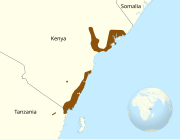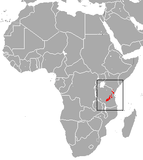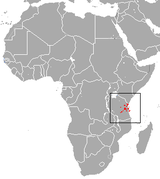Superregnum: Eukaryota
Cladus: Unikonta
Cladus: Opisthokonta
Cladus: Holozoa
Regnum: Animalia
Subregnum: Eumetazoa
Cladus: Bilateria
Cladus: Nephrozoa
Superphylum: Deuterostomia
Phylum: Chordata
Subphylum: Vertebrata
Infraphylum: Gnathostomata
Megaclassis: Osteichthyes
Cladus: Sarcopterygii
Cladus: Rhipidistia
Cladus: Tetrapodomorpha
Cladus: Eotetrapodiformes
Cladus: Elpistostegalia
Superclassis: Tetrapoda
Cladus: Reptiliomorpha
Cladus: Amniota
Cladus: Synapsida
Cladus: Eupelycosauria
Cladus: Sphenacodontia
Cladus: Sphenacodontoidea
Cladus: Therapsida
Cladus: Theriodontia
Cladus: Cynodontia
Cladus: Eucynodontia
Cladus: Probainognathia
Cladus: Prozostrodontia
Cladus: Mammaliaformes
Classis: Mammalia
Subclassis: Trechnotheria
Infraclassis: Zatheria
Supercohors: Theria
Cohors: Eutheria
Infraclassis: Placentalia
Cladus: Boreoeutheria
Superordo: Euarchontoglires
Ordo: Primates
Subordo: Strepsirrhini
Infraordo: Lemuriformes
Superfamilia: Lorisoidea
Familia: Galagidae
Genus: Paragalago
Species: P. cocos - P. granti - P. nyasae - P. orinus - P. rondoensis - P. zanzibaricus
Name
Paragalago Masters, Génin, Couette, Groves, Nash, Delpero & Pozzi, 2017
Type species: Galago zanzibaricus Matschie, 1893
Synonyms
References
Paragalago – Taxon details on Integrated Taxonomic Information System (ITIS).
Vernacular names
Deutsch: Ostafrikanischen Zwerggalagoarten
English: Eastern dwarf galagos
The eastern dwarf galagos are a group of five species of strepsirrhine primates of the family Galagidae, native to East Africa. They were formerly classified in the genus Galagoides but have been moved to their own genus, Paragalago, based on genetic evidence, and supported by differences in vocalizations and morphology.[1] The three western/Congolian species remain in Galagoides.
The two genera are not sister taxa and thus apparently evolved their small sizes and some morphological similarities via parallel evolution, although members of the eastern group tend to be larger. They are separated by the East African Rift. Paragalago is actually sister to the genus of 'lesser galagos', Galago, which are similar in size.[1] There is limited sympatry between Paragalago and the much more widely distributed Galago. Paragalago members range in mass from 60 to 250 g, considered small to medium-sized among galagids.[1]
All five species have been evaluated by the IUCN. P. orinus is considered to be vulnerable, P. rondoensis to be endangered, P. zanzibaricus is listed as near threatened, while P. cocos and P. granti are of least concern.
The Taita mountain dwarf galago, found in the Taita Hills, is unclassified.[2] Based on vocalizations, it may be the Kenya coast galago. These dwarf galagos are present in very small forest fragments and are in immediate danger of extinction.
Paragalago species
| Common name | Scientific name and subspecies | Range | Size and ecology | IUCN status and estimated population |
|---|---|---|---|---|
| Grant's bushbaby
|
P. granti (Thomas & Wroughton, 1907) |
Southeastern Africa |
Size: 14–19 cm (6–7 in) long, plus 20–27 cm (8–11 in) tail[3] Habitat: Forest[4] Diet: Invertebrates, fruit, gum, and flowers, as well as small birds[4] |
LC
|
| Kenya coast galago
|
P. cocos (Heller, 1912) |
Southeastern Africa |
Size: 14–19 cm (6–7 in) long, plus 18–23 cm (7–9 in) tail[3] Habitat: Forest[5] Diet: Insects and fruit[6] |
LC
|
| Rondo dwarf galago
|
P. rondoensis (Honess, 1997) |
Scattered Tanzania in southeastern Africa |
Size: 10–13 cm (4–5 in) long, plus 17–18 cm (7 in) tail[6] Habitat: Forest[7] Diet: Insects, as well as fruit and gum[6] |
EN
|
| Uluguru bushbaby
|
P. orinus (Lawrence & Washburn, 1936) |
Southeastern Africa |
Size: 12–14 cm (5–6 in) long, plus 16–20 cm (6–8 in) tail[3] Habitat: Forest[8] Diet: Gum, nectar, invertebrates, and small vertebrates[3] |
VU
|
| Zanzibar bushbaby
|
P. zanzibaricus (Matschie, 1893) Two subspecies
|
Scattered Tanzania |
Size: 14–15 cm (6–6 in) long, plus 12–15 cm (5–6 in) tail[9] Habitat: Forest[10] Diet: Fruit, insects, and gum[9] |
NT
|
References
Masters, J.C.; Génin, F.; Couette, S.; Groves, C.P.; Nash, S.D.; Delpero, M.; Pozzi, L. (2017). "A new genus for the eastern dwarf galagos (Primates: Galagidae)". Zoological Journal of the Linnean Society. 181 (1): 229–241. doi:10.1093/zoolinnean/zlw028. hdl:2318/1618044.
Rosti, H.; Rikkinen, J.; Pellikka, P.; Bearder, S.; Mwamodenyi, J.M. (2020). "Taita Mountain dwarf galago is extant in the Taita Hills of Kenya". Oryx. 54 (2): 152–153. doi:10.1017/S003060531900142X.
Kingdon, ch. Galagos
de Jong, Y. A.; Butynski, T. M.; Perkin, A. (2019). "Paragalago granti". IUCN Red List of Threatened Species. 2019: e.T91970347A17962454. doi:10.2305/IUCN.UK.2019-3.RLTS.T91970347A17962454.en.
Butynski, T. M.; de Jong, Y. A. (2019). "Paragalago cocos". IUCN Red List of Threatened Species. 2019: e.T136212A17963050. doi:10.2305/IUCN.UK.2019-3.RLTS.T136212A17963050.en.
Stuart; Stuart, ch. Galagos
Perkin, A. (2020). "Paragalago rondoensis". IUCN Red List of Threatened Species. 2020: e.T40652A17962115. doi:10.2305/IUCN.UK.2020-2.RLTS.T40652A17962115.en.
Perkin, A. (2021) [amended version of 2020 assessment]. "Paragalago orinus". IUCN Red List of Threatened Species. 2021: e.T40651A190242954. doi:10.2305/IUCN.UK.2021-1.RLTS.T40651A190242954.en.
Satovsky, Ryan (2006). "Galago zanzibaricus". Animal Diversity Web. University of Michigan. Retrieved June 25, 2023.
Perkin, A.; Butynski, T. M.; de Jong, Y. A. (2020) [errata version of 2020 assessment]. "Paragalago zanzibaricus". IUCN Red List of Threatened Species. 2020: e.T8790A179843811. doi:10.2305/IUCN.UK.2020-2.RLTS.T8790A179843811.en.
Sources
Kingdon, Jonathan (2020). The Kingdon Pocket Guide to African Mammals (2nd ed.). Bloomsbury Publishing. ISBN 978-1-4729-8320-6.
Stuart, Chris; Stuart, Mathilde (2017). Stuarts' Field Guide to the Larger Mammals of Africa (4th ed.). Penguin Random House South Africa. ISBN 978-1-77584-276-7.
Retrieved from "http://en.wikipedia.org/"
All text is available under the terms of the GNU Free Documentation License



